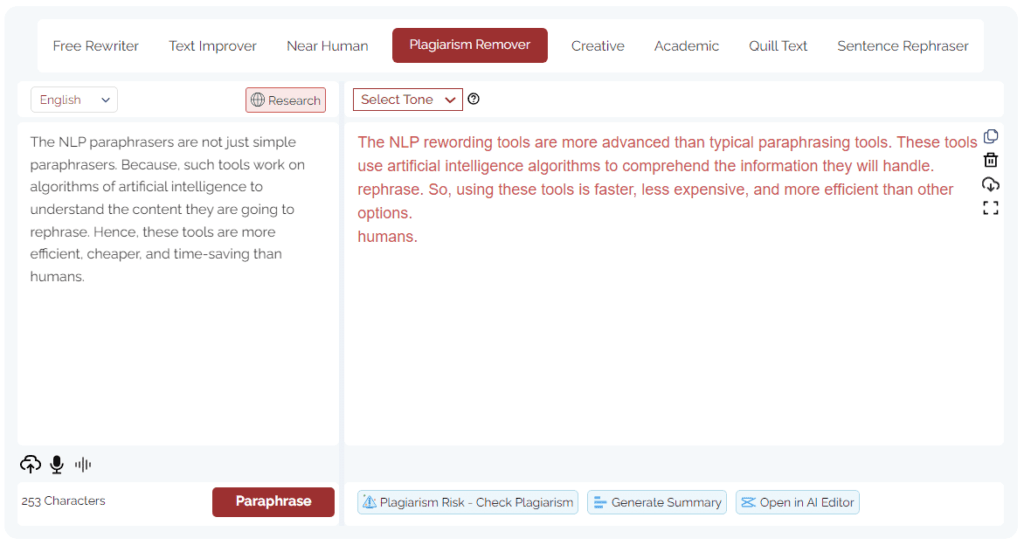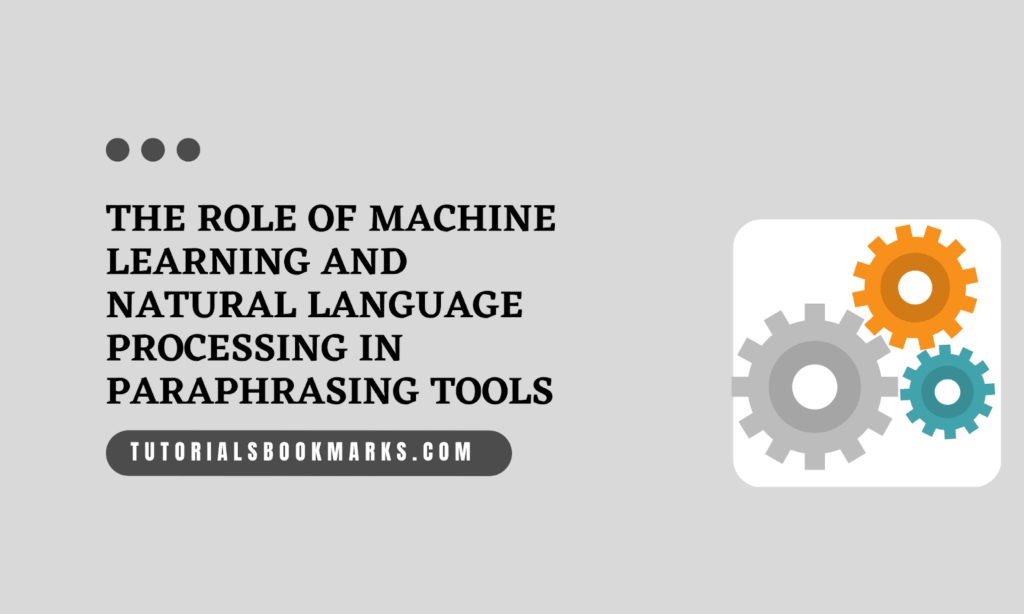If you’re a writer, student, or researcher, you know how important it is to restate existing ideas to express them in your own words. Paraphrasing is an effective technique for rewriting a text’s meaning while keeping its original message intact.
However, the process of paraphrasing can be time-consuming and challenging, especially when you’re dealing with complex or technical content.
That’s why automated paraphrasing tools are becoming increasingly popular. These tools use cutting-edge technologies such as natural language processing NLP and machine learning ML to automatically rephrase sentences and paragraphs while retaining their original meaning.
NLP is a subfield of AI that focuses on understanding and analyzing human language, while ML involves training algorithms to learn from data and make predictions.
In this post, we’ll explore the fascinating world of NLP and ML and how they work together with paraphrasing tools to make the paraphrasing process faster and more efficient.
Table of Contents
We’ll also discuss the benefits and challenges of using these technologies and how they’re transforming the way we write and communicate.
So, buckle up and get ready to dive into it straight!
Understanding Natural Language Processing
Natural Language Processing is a subfield of Artificial Intelligence that focuses on enabling machines to understand, interpret, and generate human language.
It uses a combination of linguistic, statistical, and computational techniques to analyze and process textual data. NLP allows computers to “comprehend” the nuances and complexities of human language, including its syntax, semantics, and context.
Applications of NLP
Natural Language Processing has revolutionized the way we interact with language and has numerous applications across a variety of fields. Here are some of its most common applications:
- Text summarization to reduce a large amount of text into a more concise version without losing the original text context. This is particularly useful for generating summaries of news articles, research papers, and legal documents.
- Automatic text generation to generate text based on a given set of data. This can be useful in creating chatbots, autoresponders, and personalized recommendations.
- Natural language understanding to interpret a natural language input and convert it into data that can be used by a computer program. This is crucial for applications such as voice assistants, search engines, and customer service bots.
- Machine translations to translate text from one language to another.
- Question answering to answer questions posed in a natural language. Ideal to be used in chatbots, customer service bots, and virtual assistants.
- Sentiment analysis analyzes the sentiment of a given text and determines whether it is positive, negative, or neutral. This is useful for applications such as brand monitoring, customer feedback analysis, and social media sentiment analysis.
Read: 5 Essential Skills for a Successful Career in Technology
Understanding Machine Learning
Machine Learning is also a subset of Artificial Intelligence AI that focuses on developing computer algorithms that can learn and improve automatically with experience.
ML algorithms build mathematical models based on training data and use these models to make predictions or decisions without the need for custom programming.
Applications of Machine Learning
ML finds applications in a wide range of domains, from data mining and natural language processing to image recognition and robotics.
For example, ML algorithms can be used to identify patterns in large datasets, recognize speech or text, and even control autonomous robots.
As such, ML has the potential to transform many industries and enhance our ability to solve complex problems.
The Role of ML and NLP in Paraphrasing Tools
NLP and ML are essential components in the development of an efficient paraphrasing tool. NLP helps to identify the structure of language and understand the context of a sentence, enabling the accurate reformulation of the text while maintaining its original meaning.
This is made possible by identifying the relationships between words and accurately identifying the meaning of a sentence.
On the other hand, ML algorithms are trained on large datasets to identify patterns and learn from them, allowing for the creation of powerful algorithms that can generate accurate paraphrases. This process eliminates the need for manual programming and enables the tool to improve over time with more data.
When NLP and ML work together, the result is a tool that can effectively paraphrase a given text by identifying the meaning, understanding the context, and generating accurate reformulations. With the growing need for efficient and accurate language processing, the use of NLP and ML in paraphrasing tools is becoming increasingly important.
How Do These Paraphrasing Tools Work? (A Step-by-Step Method)
Based on ML and NLP, the paraphrasing tools are often referred to as AI-based paraphrasing tools.
The AI paraphrasing tools are typically algorithms that use machine learning and NLP to carry out their designated tasks, such as rephrasing or remodeling text.
With the aid of these technologies, paraphrasing tools can rapidly generate high-quality rephrased content without requiring manual input.
This is how these AI paraphrasing tools work:
- Analyzing the input text using NLP algorithms to identify its structure and meaning.
- Then using machine learning algorithms to identify patterns in the input text and learn how to generate accurate paraphrases.
- Based on the learned patterns, the tool selects and replaces words and phrases with their synonyms or semantically similar alternatives.
- The tool may also modify sentence structure, change the voice from active to passive, and other techniques to create a new sentence while retaining the meaning of the original text.
- The resulting output is a rephrased version of the input text that is unique and can be used in various applications.
Example of an AI-based Paraphrasing Tool
With the advancements in NLP and ML technologies, numerous paraphrasing tools have been developed to help writers generate high-quality content.
Let’s take a closer look at one of the most popular tools – Paraphrasingtool.ai
which utilizes NLP and ML algorithms in its backend to create meaningful paraphrased content.
Paraphrasingtool.ai and its features
Paraphrasingtool.ai is a well-known paraphrasing tool that stands out from the rest due to its user-friendly features and accurate results.

Its advanced AI technology, backed by NLP and ML, generates high-quality and human-readable content in a matter of seconds. The tool is ideal for anyone who wants to paraphrase content quickly and effectively. Its main features include:
- Advanced AI technology: Paraphrasingtool.ai employs state-of-the-art Artificial Intelligence algorithms to create natural and readable content that sounds human-written.
- Multilingual support: The tool offers support for a wide range of languages, including English, Spanish, German, French, Italian, and Dutch.
- Synonym database: The tool has an extensive database of synonyms, enabling it to accurately rephrase sentences and replace words with their equivalent meanings.
- Easy-to-use interface: The tool features a simple and intuitive user interface that guides users through the paraphrasing process.
- Audio paraphrasing: This feature would allow users to upload audio files and receive a paraphrased version of the spoken content.
- Speech-to-Text paraphrasing: This feature would allow users to input spoken content directly through their microphone, and receive a paraphrased version of the text output.
- Different Tones for paraphrasing: This feature would enable users to choose different tones for the paraphrased content, such as casual, formal, professional, or witty.
- Direct search panel: This feature would allow users to input their search query directly into the web search to extend the research on the subject matter.
- Multiple modes: The tool offers eight different paraphrasing modes, catering to the needs of various users, including students, researchers, and content writers. These modes are Free Rewriter, Text Improver, Near Human, Plagiarism Remover, Creative, Academic, Quill Text, and Sentence Rephraser.
Conclusion
In a nutshell, the combination of Natural Language Processing and Machine Learning has brought significant advancements in paraphrasing tools, enabling them to quickly rephrase sentences and paragraphs while retaining their original meaning.
These technologies have numerous applications, including text summarizer, automatic text generation, sentiment analysis, and machine translations.
By working together, NLP and ML algorithms help paraphrasing tools analyze the structure of language, understand the context of a sentence, and generate accurate paraphrases.
Paraphrasingtool.ai is a good example of such a tool, which can be beneficial to writers, students, and researchers, making the paraphrasing process more efficient and less time-consuming.
